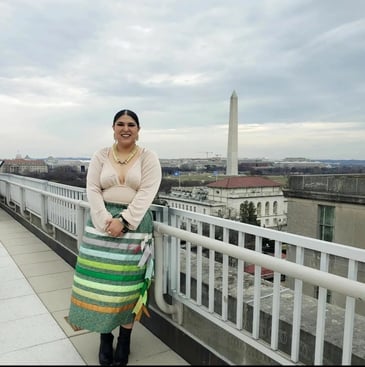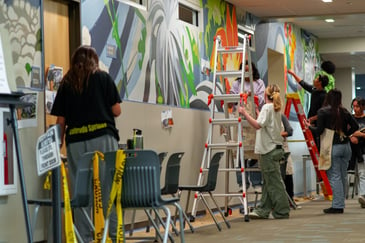Giving & Cheer Day 3: Amanda Evans on the Core Value of Responsibility
Hello my name is Amanda Evans and I am the 7th Grade Special Education teacher and Special...

Hello my name is Amanda Evans and I am the 7th Grade Special Education teacher and Special...

During her time at DSST, Hannah Hathaway was deeply committed to facilitating deep learning among...

Hello all, my name is Megan Schierbeck, and I run our only Affective Needs program in the DSST...

Zenetta Zepeda graduated from DSST: Montview in 2016.

DSST: Conservatory Green High School’s Visual Arts 3 - Industry Connect and AP Drawing classes...

The 14-year-old wants to become a nurse someday.She lives in Aurora, adjacent to the Anschutz...
-Jan-08-2024-07-14-47-2772-PM.png?width=365&name=MicrosoftTeams-image%20(18)-Jan-08-2024-07-14-47-2772-PM.png)
Have you ever considered taking your career in education to the next level? If so, you're not...

Voting represents a powerful opportunity to ensure your voice reverberates through the halls of...

The DSST-Montview High’s robotics team took two of the top four places in the Kendrick Castillo...
-Sep-29-2023-04-36-42-3425-PM.png?width=365&name=MicrosoftTeams-image%20(6)-Sep-29-2023-04-36-42-3425-PM.png)
In honor of Hispanic Heritage Month, we connected with DSST alum, Amelia Federico, to celebrate and...
Hello my name is Amanda Evans and I am the 7th Grade Special Education teacher and Special Education and Gifted and Talented Admin at DSST: GVR Middle School (Shoulda’ Been a Raptor)! I am the 2022 Responsibility Core Value Award Winner, and am thankful to my team for the honor of being selected for this award.
Topics: News, Updates, & Events
During her time at DSST, Hannah Hathaway was deeply committed to facilitating deep learning among her students in biology and drew many connections to various initiatives happening in our communities. Hannah was instrumental in building the vision for DSST programming that will continue to impact students and programming into the future.
In considering Hannah's investment in the biosciences, and her value of community partnership, her donation will go to benefit The Sand Creek Regional Greenway, a nearly 13-mile public trail and natural area located in the northeast Denver metro area.
The Sand Creek Regional Greenway Partnership was established to protect, maintain and enhance the Sand Creek Regional Greenway, and is committed to enhancing the equitable access, awareness, and engagement of the Greenway.
Topics: News, Updates, & Events
Hello all, my name is Megan Schierbeck, and I run our only Affective Needs program in the DSST Network at Cole High School! I could not have won this award on my own. It was a massive team effort for everyone who works at Cole, and especially the support specialists -- Sue Wolf, Amanda Molinar, Valeria Mendoza, and Rubi Estrada -- who ensure that our program runs smoothly and students receive the support they deserve with the support of our mental health team Alex Wirth and Mackenzie Brees.
Topics: News, Updates, & Events
Zenetta Zepeda graduated from DSST: Montview in 2016.
Topics: News, Updates, & Events
DSST: Conservatory Green High School’s Visual Arts 3 - Industry Connect and AP Drawing classes recently undertook a transformative project that left an indelible mark on their school.
Topics: Inside the Classroom
The 14-year-old wants to become a nurse someday.
She lives in Aurora, adjacent to the Anschutz Medical Campus, the only academic medical center in the Rocky Mountain region. Also on campus is Bri Hayes’ innovative school, Aurora Science & Tech (AST).
Even so, Bri had never met a nurse until she and her fellow AST ninth graders took a field trip and walked from their school at 2450 N. Scranton St. a few blocks south to see the ER and other parts of UCHealth University of Colorado Hospital.
Topics: News, Updates, & Events
Have you ever considered taking your career in education to the next level? If so, you're not alone. Many educators dream of becoming leaders within their schools and making a more profound impact on the lives of students. One way to achieve this dream is through programs like DSST's Teacher Leader Pipeline, a unique initiative that paves the way for aspiring education leaders to grow and flourish.
Topics: News, Updates, & Events
Voting represents a powerful opportunity to ensure your voice reverberates through the halls of decision-making. This election season, the ballot is teeming with critical issues that directly impact our community. The decisions made in this election will shape the future of our education system, influencing aspects such as school safety, budget allocation and more.
Topics: News, Updates, & Events
The DSST-Montview High’s robotics team took two of the top four places in the Kendrick Castillo Memorial Tournament on Oct. 14 and 15 at Regis University while exhibiting valuable non-tech skills.
Known as Brute Force, the team fielded two machines, veteran first teamer Moonwalker, and Ankle Biter, a scrappy and endearing newcomer as number two. After the qualification round the tournament’s remaining teams joined alliances formed with three other schools. Ankle Biter took second place and Moonwalker was fourth in the tournament; Ankle Biter beat Moonwalker along the way to earn its finish.
Check out the full story here.
Topics: News, Updates, & Events
In honor of Hispanic Heritage Month, we connected with DSST alum, Amelia Federico, to celebrate and highlight their talents, skills and wonderful contributions to the Hispanic community.
Topics: News, Updates, & Events